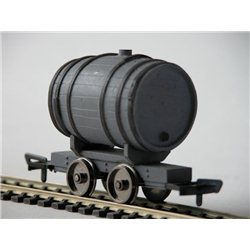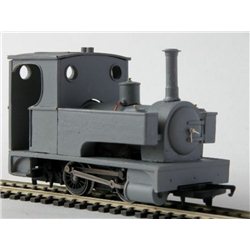Static grass puffer bottles work by manually charging model grass fibres with static electricity. When the charged...
No products
Product successfully added to your shopping cart
There are 0 items in your cart. There is 1 item in your cart.
Search Tips
What is On30?
On30, also known as O scale narrow gauge, is a popular model railway scale in which models are built at a ratio of 1:48, representing narrow gauge railways on 30-inch (762 mm) track. In British terms, this is akin to modelling 2'6" gauge railways, though the scale has its roots in American model railroading. The 'O' in On30 refers to the scale, while 'n' denotes narrow gauge, and '30' indicates the track gauge in inches. This scale has gained popularity for its versatility and the rich history of narrow gauge railways it represents.
In the United States, On30 modelling typically represents railways used for logging, mining, and other industrial purposes, often found in remote or rugged terrains. These lines were cheaper to build than standard gauge railways, allowing them to navigate difficult landscapes and serve small, specialised industries. In the UK, modellers often use On30 to recreate similar industrial or rural scenes, sometimes drawing inspiration from narrow gauge railways in Wales, the Lake District, or Scotland, where narrow gauge lines were common for slate quarries, mines, and small branch lines.
One of the key attractions of On30 is the ability to use HO scale (1:87) track, which represents the narrow gauge track when used with O scale models. This makes On30 more accessible and affordable, as modellers can repurpose readily available HO track and mechanisms. Additionally, the larger size of the models in O scale allows for greater detailing, making the scenes more realistic and visually engaging. This scale also appeals to those who enjoy scratch-building or kit-bashing, as it provides ample room for creativity and customisation.
On30 has been well-supported by manufacturers, particularly in the United States, with companies like Bachmann producing a range of ready-to-run locomotives, rolling stock and accessories. These products have been instrumental in making On30 accessible to a broader audience, enabling enthusiasts to build extensive layouts without the need for extensive scratch-building. However, the scale also has a strong following among modellers who prefer to build their own rolling stock and scenery, often using On30 as a canvas for unique and imaginative creations.
The scale is well-suited to small layouts, making it ideal for those with limited space. The narrow gauge nature of On30 allows for tighter curves and more compact track plans, which are perfect for creating detailed, intricate scenes in a small area. This makes it a popular choice for modellers who enjoy creating highly detailed dioramas or those looking to capture the charm of a small, self-contained railway.
Overall, On30 offers a blend of accessibility, creativity, and historical interest that appeals to a wide range of railway modellers. Whether you're drawn to the historical accuracy of narrow gauge lines, the hands-on aspect of building and detailing models, or simply the visual appeal of larger scale modelling, On30 provides a flexible and engaging platform. It's a scale that bridges the gap between fine detail and practicality, making it a compelling choice for both newcomers and seasoned enthusiasts in the world of model railways.
Click here to receive the tips weekly in your mailbox. You can unsubscribe at any time.










